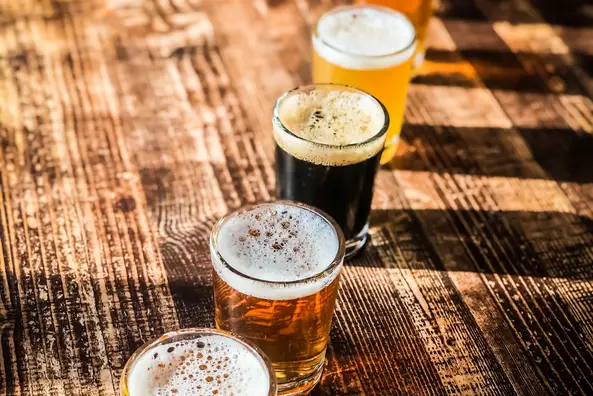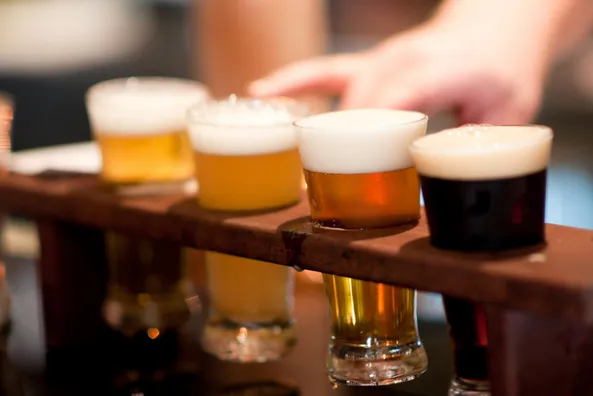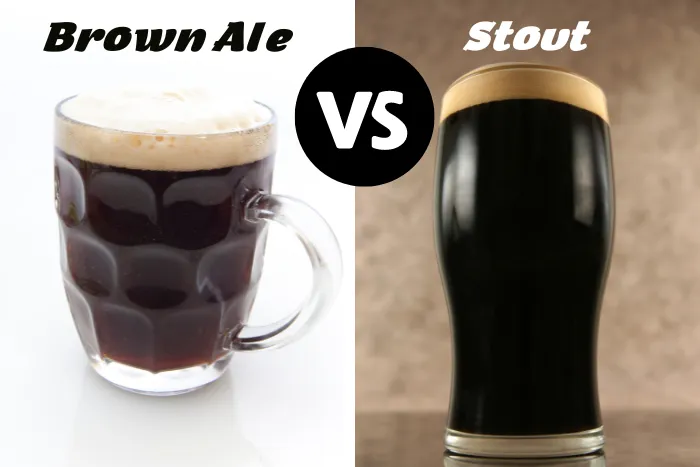The debate between brown ale and stout has been around for centuries, with both beer styles having a long history in Europe. From the brewing process to the taste profile, color, alcohol content, and calorie content – there are many differences between these two types of beers that make them unique. In this blog post, we’ll explore all aspects of brown ale vs. stout so you can decide which one is best suited for your palate!
We will also look at famous examples from each style to help guide your decision-making. So if you’re looking for an informative article about two classic beer styles, read on as we delve into the world of brown ales versus stouts!
Table of Contents:
- History of Brown Ale and Stout
- Brewing Process for Brown Ale and Stout
- Taste Profile of Brown Ale vs Stout Beers
- Color, Alcohol Content, and Calorie Content Comparison Between Brown Ale and Stout Beers
- Popular Examples of Each Style of Beer
- FAQs in Relation to Brown Ale vs Stout
- Conclusion
History of Brown Ale and Stout

Origin of Brown Ale
Brown ale is a style of beer that has been around for centuries. It originated in England, where it was first brewed in the late 1500s. The original brown ales were made with dark malts and roasted barley, giving them their characteristic deep amber color and nutty flavor. Over time, brewers began experimenting with different ingredients and techniques to create new variations on the classic brown ale recipe. Today, many kinds of brown ales are available from all over the world.
Origin of Stout
Stout is another type of beer that also has its roots in England. It was first brewed by London-based brewer Arthur Guinness in 1759 using a combination of pale malt, black patent malt, hops, yeast, and water. This unique blend gave stout its signature dark color and full flavor profile, quickly becoming popular among European drinkers and eventually spreading across the globe.
Evolution of Brown Ale and Stout
Since their inception centuries ago, both styles have evolved significantly over time due to advances in brewing technology and craft brewers’ experimentation. They have created new variations on these classic recipes using different ingredients such as fruits or spices or even aging them in oak barrels for added complexity. As a result, today’s market offers an array of both traditional stouts like Guinness Extra Stout and more modern takes such as Imperial Stouts aged in whiskey barrels or flavored with coffee beans or chocolate nibs – to name a few examples.
Brown Ale and Stout have a long and varied history, but brewing has evolved to create unique flavor profiles. In this article, we will explore the ingredients used in both types of beer and how they contribute to their distinct flavors.
Brewing of Brown Ale
Brown ale and stout are two of the most popular beer styles but have very different brewing processes. Brown ales typically use pale malts as their base malt, with specialty grains like chocolate or crystal added for flavor. Hops are usually used to balance the sweetness from the malt, and some brown ales may also contain spices such as cinnamon or nutmeg. The fermentation process is generally slower than other beers, allowing more complex flavors to develop.
Brewing of Stout
Stouts are brewed using dark roasted malts that give them a deep black color and a rich flavor profile. Roasted barley is often used in stouts to provide coffee-like notes, while hops help add bitterness and balance out the sweetness of the malt. Yeast strains used in stouts tend to be less aggressive than those used in other beers, which helps preserve some of the sweeter notes from the malt during fermentation.
The brewing process for brown ale and stout is intricate, requiring knowledge of the different ingredients used and a keen eye to ensure a good quality beer. Now let’s explore how these two beer styles differ in taste profile.
Taste Profile of Brown Ale vs Stout Beers
Brown ales and stouts are two of the most popular styles of beer, each with its own unique flavor profile.
Taste Profile of Brown Ale
Brown ales are light-bodied beers characterized by their malty sweetness and nutty flavors. Famous examples of brown ale include Newcastle Brown Ale, Samuel Smith’s Nut Brown Ale, and Sierra Nevada Tumbler Autumn Brown Ale. These beers have a mild hop bitterness balanced out by the sweet maltiness in the beer.
Taste Profile of Stout
On the other hand, stouts are dark-colored beers with intense roasted coffee or chocolate flavors. Famous stout examples include Guinness Draught Stout, Left Hand Milk Stout Nitro, and North Coast Old Rasputin Russian Imperial Stout. Stouts typically have higher alcohol content than brown ales due to their more intense flavor profiles which come from longer aging times during fermentation and additional ingredients such as oats or lactose sugar for added body and texture.
Typical tasting notes for both styles of beer include:
- Caramelized sugars.
- Nuts.
- Coffee/chocolate notes (for stouts).
- Toastiness/biscuit notes (for brown ales).
- Earthy hops character (for both styles).
- Some fruit esters depend on the yeast strain used in the fermentation process.
Both styles can also have subtle smoky aromas due to roasting malts used in brewing. However, this will vary depending on the individual recipe formulation used by the brewer when making a particular style of beer.
Brown ales and stouts have different flavor profiles, colors, alcohol, and calorie content. In the next section, we will compare the characteristics of the two beer styles to help you decide which is right for you.
Color, Alcohol Content, and Calorie Content Comparison of Brown Ale and Stout Beers

Color Comparison:
The color of a beer is one of the most noticeable differences between brown ales and stouts. Brown ales are typically light to medium-brown in color, while stouts tend to be much darker, with shades ranging from dark brown to black. In terms of clarity, both styles can vary from hazy to clear depending on the brewing process used.
Alcohol Content Comparison:
When it comes to alcohol content, there is also a difference between these two styles of beer. Generally speaking, brown ales have an ABV (alcohol by volume) that ranges from 4% to 6%, while stouts usually have an ABV from 5% to 8%. Stouts will generally be more potent than their brown ale counterparts.
Calorie Content Comparison:
Looking at calorie content, there is a difference between these two beer styles. On average, a 12 oz serving of a brown ale will contain around 150 calories, whereas the same size stout serving will have about 200 calories due to its higher alcohol content. However, this number can vary depending on the specific recipe used for each style, so it is important to check labels before consuming any alcoholic beverage if you are trying to watch your calorie intake.
Brown ales and stouts have distinct differences in color, alcohol, and calorie content. To learn more about the famous examples of each beer style, read out which beers are considered favorites among craft beer enthusiasts.
Popular Examples of Each Style of Beer
Popular Examples of Brown Ales:
Brown ales are a type of beer that is dark amber to brown and taste malty. Newcastle Brown Ale, Sam Adams Brown Ale, and Sierra Nevada Tumbler Autumn Brown Ale are all well-known beers in this style. These beers taste smooth and nutty, with hints of chocolate and caramel. They also tend to be lighter regarding alcohol content, usually ranging from 4-6% ABV.
Popular Examples of Stouts:
Stouts are a darker beer style with a roasted malt flavor ranging from sweet to bitter, depending on the variety. Famous examples include Guinness Draught Stout, Left Hand Milk Stout Nitro, and Founders Breakfast Stout. These beers typically have an ABV between 5-8%, making them slightly stronger than brown ales but still relatively light compared to other styles, such as imperial stouts or barleywines, which can reach up to 12% ABV or higher. The flavors in these stouts vary greatly; some may be more coffee-like, while others may feature notes of chocolate or even vanilla for added sweetness.
FAQs in Relation to Brown Ale vs Stout
Is Guinness a brown ale?
No, Guinness is not a brown ale. It is a stout beer, darker and heavier than an ale. Stouts are brewed with roasted malt or barley, hops, water, and yeast. Brown ales are lighter in color and body than stouts and have more of a malty flavor profile. They also tend to be less bitter than stouts due to fewer hops during brewing.
What is the difference between a stout and an ale?
Stouts and ales are both types of beer, but they differ in several ways. Ales are brewed with top-fermenting yeast, which ferments at warmer temperatures than bottom-fermenting lager yeasts. This gives ales a more fruity flavor profile compared to stouts. Stouts use roasted malts that give them a darker color and more robust flavor than ales. Additionally, stouts tend to have higher alcohol content due to the extra sugars from the malt used during brewing. Finally, while some stouts can be sweet or creamy, most have a dry finish not present in ales.
What kind of beer is brown ale?
Brown ale is a type of beer that ranges in color from copper to dark Brown. It typically has a malty flavor with notes of caramel, chocolate, and sometimes nuts. Brown ales are usually low in hop bitterness and have an ABV (alcohol by volume) ranging from 4-6%. They are often considered session beers due to their lower alcohol content and easy drinkability. Brown ales can be enjoyed alone or paired with roasted meats, smoked fish, aged cheeses, or desserts like chocolate cake.
Is brown ale the same as dark ale?
No, brown ale and dark ale are not the same. Brown ales tend to be maltier in flavor with a hint of caramel or chocolate, while dark ales are usually more robust and have notes of coffee, roasted malts, and burnt sugar. Brown ales typically range from light amber to deep brown, whereas dark ales can vary from deep copper to almost black. Both styles offer unique flavors that make them enjoyable for different occasions.
Conclusion
In conclusion, brown ale and stout beers are two distinct beer styles with unique characteristics. Brown ales tend to be lighter in color with a sweeter taste profile, while stouts are darker with a more robust flavor. Both styles also differ when it comes to alcohol content and calorie count. When comparing brown ale vs. stout, the best way to determine which one is right for you is by trying different examples of each style and seeing which one suits your taste preferences better.
Are you a beer lover who wants to know more about the different styles of beers? Are you seeking reviews and advice on the best brown ales and stouts? Look no further! Our blog provides detailed, unbiased reviews to help you decide which brew suits your taste. Plus, we provide information on various beer-related topics, such as equipment, subscription services, and even how to make your beer at home. Check out our blog today so you can start making informed decisions about choosing the perfect ale or stout!
Also See: The Best Low Purine Beer: Top 10

